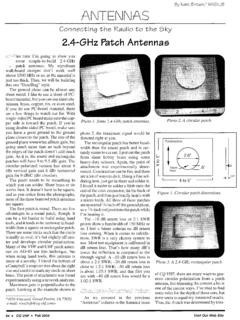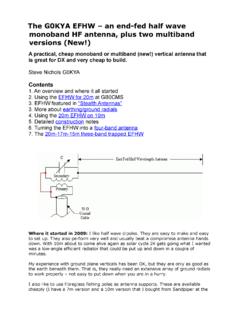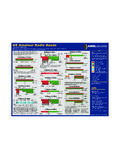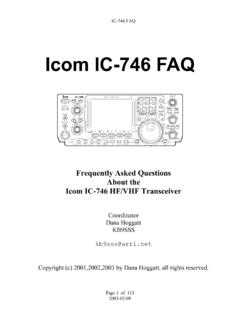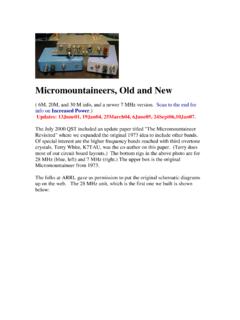Transcription of A PIC SWR Meter - N5DUX
1 40 December 1999 Noham shack is completewithout an SWR Because your rig ismost content when it can seean SWR of 2:1 or less. To make your righappy, you should know the SWR levelbetween the rig and the tuner or do you do that? With an SWR Meter ,of course!I designed this SWR Meter to use fewparts, to be inexpensive and easy to Meter has two subassemblies: the pro-cessing unit and the SWR sampling dc samples of forward and reversevoltage are processed by a programmedPIC1 microcontroller that computes theSWR and directly drives a large bright dis-play. No calibration against another stan-dard is necessary because the computednumber is the SWR.
2 The SWR is displayedas two digits units and tenths of a processor and the display are mountedon a small PC board that mounts on SWRThe PIC has four ADCs (two of whichare used in this application), RAM, theEPROM containing the program and anoscillator everything needed in one small18-pin package. There s more than enoughon-board power in the PIC to directly drivethe large LED display. The flow chart ofshows how the PIC s program calculatesSWR. The PIC s ADCs translate the two dcinputs from the sampling unit into twohexadecimal number equivalents identifiedas FWD and REV. The program determinesif the FWD sample is sufficiently high tomake an accurate measurement.
3 If not, theletters LP (for low power ) are the input is high enough, the PIC s soft-ware uses the following equation to arriveat an SWR value:2(FWD + REV) / (FWD REV) = SWR(Eq 1)where SWR is a hexadecimal numberplus any remainder, processor works with hexadecimalnumbers that must be converted to decimalfor display. If executing Equation 1 resultsin an SWR of 10 or more, the display indi-cates HI. If the value is less than 10, theSWR is equal to a decimal value between 1and 9, because those numbers are the sameBy Bert Kelley, AA4 FBA PIC SWR Meter1 Notes appear on page an SWRmeter for yourshack? Build thiscomputing SWRmeter!in the hexadecimal and decimal numberingsystems. The quantity (FWD REV) isequal to one unit of SWR.
4 REM, alwaysless than the divisor, is converted to deci-mal by multiplying by 0Ah (10 decimal),then dividing again by (FWD REV). Thisgives the answer in tenths of an SWR left to right, the display shows units,a decimal point and the tenths SWR new SWR calculation is made every and Circuit DescriptionIn the prototype, the processing unit ismounted behind the enclosure s frontpanel, with the sampling circuit secured tothe rear panel. C1 and C2 of Figure 2 pro-vide a time constant appropriate for capacitors should be tantalum unitsbecause they also serve to remove stray capacitors are physically smallerand are better RF bypasses than aluminumelectrolytic PIC (U1) is a high-impedanceCMOS device, so observe proper handlingprecautions and use a wrist strap.
5 R3 andR4 ensure that the maximum recommendedinput source impedance is not exceeded atany setting of R1 (FWD) and R2 (REV).Although the digits displayed on DS1 ap-pear to be on continuously, they are alter-nately illuminated. U2 (a BCD-to-decimaldecoder/driver) selects which digit is on ata given time. If you follow my constructiontechnique, use a low-profile crystal in theoscillator circuit because physical clear-ance above the crystal is limited. Most 9-Vplug-in transformers usually have suffi-cient dc filtering so no more is needed onthe PIC board. C7 serves as a regulator-oscillation suppressor; C8 provides glitchsuppression when U1 and U2 DS1, I selected a bright green, , two-digit common-cathodePanasonic display that can be seen easilyfrom a distance.
6 The display segments areconnected in parallel; that is, segments a, b,c, etc, of one digit connect to like segmentson the other digit. Of course, if you use theready-made PC board (see Note 1), thiswiring is already done for you. (Other com-mon-cathode displays can be used, but theymay not fit the ready-made PC board.) Ichecked the possibility of using Radio-Shack s 276-075 red displays are easy to find, but theirvisibility, brightness and size pale in com-parison to the recommended display. If youelect to use the RadioShack displays, you llneed to make your own PC board for display-segment interconnections canbe worked out by referring to the segmentdesignations shown in Figure 2 and onRadioShack s mounting parts on the PC board,use it as a template to mark on the enclosurethe location of the four corner mountingholes and those for R1, R2 and the the FWD and REV test points usingleads from C3 and C4.
7 When you install thetwo capacitors, allow their ungroundedleads to project from the back of the boardby about 1/4 inch. (These test points are usedwhen calibrating the circuit.) Space thedisplays from the board so they projectthrough the panel cutout when the board is3/8-inch or so away from the panel. If youcan t find 3/8-inch spacers to mount the dis-play board, 3/4-inch-long #4-40 machinescrews each equipped with three nuts andsecured to a corner of the board will dothe job. Sampling UnitThe sampling unit (Figure 3) I selectedis similar to the one shown in The It has a fairly constant dc out-put at 100 W on all bands from 160 through10 meters and delivers the proper samplingvoltages.
8 I modified the circuit to suit theDecember 199941parts available and made it easier to pickup voltage decreases as T1 turnsare increased. For handling a power levelof 1 kW, the Handbook suggests using 40turns on the core. In my prototype, I usedsmall pieces of unetched PC board materialsecured to the PC-board groundplane withepoxy cement to serve as insulated solder-ing points for all the components, includ-ing the nulling capacitor. The photo showsthe FWD and REV outputs filtered byfeedthrough capacitors (optional) mountedon a shield. The shield may not be needed,but it helps brace the cabinet s somewhatflimsy rear panel. I used parallel resistorcombinations at R10 through R13 becausethose values were stocked Handbook refers to small changes inindicated SWR as power is increased;4 thismeter exhibits the same effect.
9 The changeis caused by differences in diode conduc-tion with current. Because the change is inthe order of one or two tenths of an SWRunit, it is of no importance. Placing two1N34 diodes in parallel reduces this effect,so I kept them in the circuit. I suggest youuse 1N34 diodes with transparent bodies;the 1N34 RadioShack diodes with cyan-col-ored bodies of the same part number exhibita greater variation in plugging in the ICs, check thepower-supply output to be sure it s and That done, turn off thesupply, insert the ICs (verifying properorientation) and apply power. The displayshould greet you by showing LP. If it doesnot, some easy troubleshooting is calledfor.
10 Ensure the oscillator is running by lis-tening for the presence of its 4-MHz signalwith your station receiver. If that s okay,the PIC is probably working. At U1, pin 1,is a handy test signal. Temporarily attach apiezo element (RadioShack 273-071 orsimilar) not a buzzer between U1 pin 1and ground. You should hear a loud tone ofabout 368 Hz. If this tone is present, thePIC is driving the displays. If the displayproblem persists, check the display connec-tions and ensure U2 is properly seated in the display shows LP, you maywant to verify the PIC s calculation perfor-mance. It is an interesting test. See Figure 4for a simple hookup to simulate all possibleSWR shown in Figure 4, connect the FWD Vtest-circuit pot to the +5-V regulated supply(verify the voltage) and connect the arms ofthe FWD and REV pots of Figure 4 to theappropriate test points of Figure 2.


